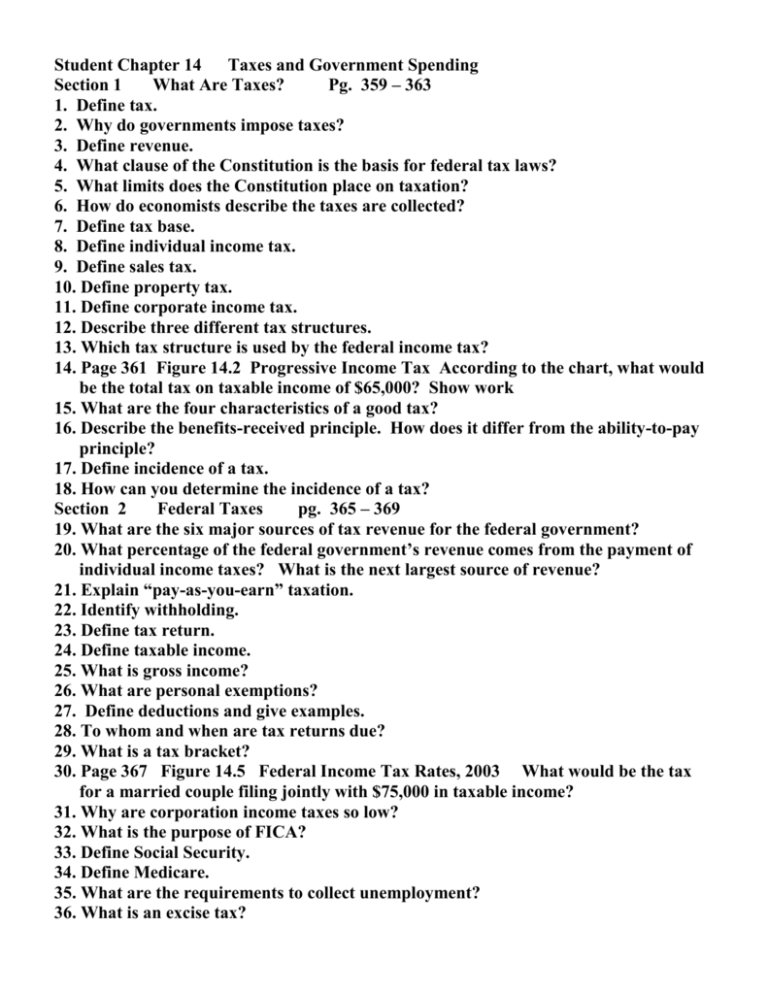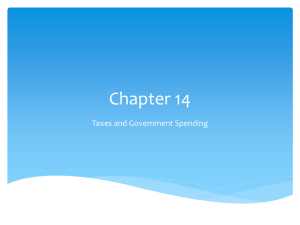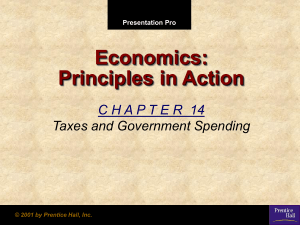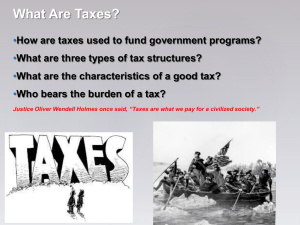Answers Chapter 14 Taxes and Government Spending
advertisement

Student Chapter 14 Taxes and Government Spending Section 1 What Are Taxes? Pg. 359 – 363 1. Define tax. 2. Why do governments impose taxes? 3. Define revenue. 4. What clause of the Constitution is the basis for federal tax laws? 5. What limits does the Constitution place on taxation? 6. How do economists describe the taxes are collected? 7. Define tax base. 8. Define individual income tax. 9. Define sales tax. 10. Define property tax. 11. Define corporate income tax. 12. Describe three different tax structures. 13. Which tax structure is used by the federal income tax? 14. Page 361 Figure 14.2 Progressive Income Tax According to the chart, what would be the total tax on taxable income of $65,000? Show work 15. What are the four characteristics of a good tax? 16. Describe the benefits-received principle. How does it differ from the ability-to-pay principle? 17. Define incidence of a tax. 18. How can you determine the incidence of a tax? Section 2 Federal Taxes pg. 365 – 369 19. What are the six major sources of tax revenue for the federal government? 20. What percentage of the federal government’s revenue comes from the payment of individual income taxes? What is the next largest source of revenue? 21. Explain “pay-as-you-earn” taxation. 22. Identify withholding. 23. Define tax return. 24. Define taxable income. 25. What is gross income? 26. What are personal exemptions? 27. Define deductions and give examples. 28. To whom and when are tax returns due? 29. What is a tax bracket? 30. Page 367 Figure 14.5 Federal Income Tax Rates, 2003 What would be the tax for a married couple filing jointly with $75,000 in taxable income? 31. Why are corporation income taxes so low? 32. What is the purpose of FICA? 33. Define Social Security. 34. Define Medicare. 35. What are the requirements to collect unemployment? 36. What is an excise tax? 37. What are estate taxes? 38. What is a gift tax and why was it enacted? 39. What is the purpose of tariffs? 40. Define tax incentive. Give example. Section 3 Federal Spending pg. 371 – 374 41. Define mandatory spending. 42. Define discretionary spending. 43. Page 371 Figure 14.6 Federal Spending, 2003 Analyze the categories of expenditures in the federal budget. Which categories receive the most federal funds? 44. What is an entitlement program? 45. What does Social Security provide? 46. What does Medicare provide and how is it funded? 47. What does Medicaid provide? 48. Why is the cost of the Social Security program expected to increase in the next decade? 49. What is the largest category of discretionary spending? Identify three additional examples of discretionary spending. Section 4 State and Local Taxes and Spending pg. 375 – 380 50. Describe the difference between a state’s operating budget and its capital budget. 51. What is a balanced budget? 52. Where are state taxes spent? 53. From where does the largest amount of state revenue come? 54. What limits are placed on state taxation? 55. Define tax exempt. 56. Define real property. 57. Define personal property. 58. What is the major source of tax revenue for local governments? 59. Page 379 Figure 14.8 Local Revenue and Spending, 2001 What are the major categories of local government spending? How do they differ from the major categories of state government spending shown on page 376? 60. Identify tax assessor. Study Guide Chapter 14 What limits does the Constitution place on taxation? Tax base Individual income tax Corporate income tax Proportional tax Regressive tax Incidence of a tax How can you determine the incidence of a tax? Withholding Tax return Deductions FICA purpose Social Security Medicare Excise tax Estate tax Tariff Tax incentive Mandatory spending Discretionary spending Entitlement programs Medicaid Balanced budget Tax exempt Real property What is the major source of tax revenue for local governments? Tax assessor











